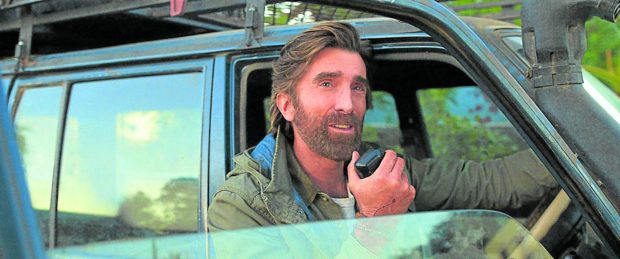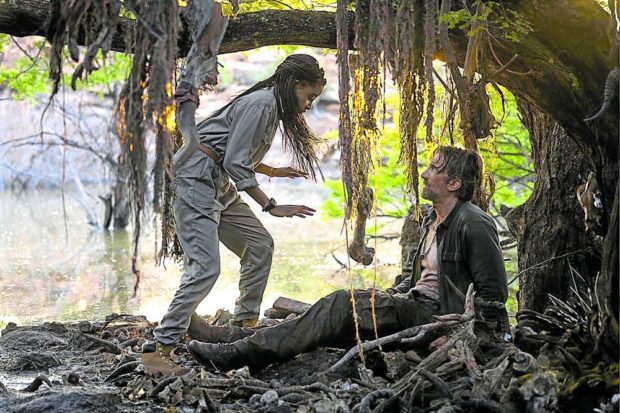There are two families in peril in Baltasar Kormakur’s man-versus-lion thriller “Beast”: The family of Dr. Nate Samuels (Idris Elba), whose members are still reeling from the death of Nate’s cancer-stricken ex-wife, and the vengeful lone male survivor from a pride of lions slaughtered by remorseless poachers. All hell breaks loose when Nate and his girls cross paths with the very angry animal.
Providing ample support for Idris and the young actresses cast as his character’s teenage daughters, Mare (Iyana Halley) and Norah (Leah Jeffries), is Sharlto Copley, the terrific South African actor who first caught our attention in Neill Blomkamp’s 2009 sci-fi action-thriller “District 9.”
In the Universal Pictures release, which began its theatrical run in Philippine cinemas on Wednesday, Sharlto plays wildlife biologist Martin Battles, an antipoaching advocate who manages a game reserve in South Africa. Martin is close to the Samuels family because it was he who introduced Nate to his wife. So it’s understandable for him to feel responsible for Nate and his daughters’ safety when sh*t hits the fan and the lion goes on a killing spree.
“In the long run, I believe that humans will never outsmart nature because we’re also a product of nature,” said Sharlto when we spoke to him in a roundtable interview. “It’s like, you can’t supersede the thing that created you.
“You know, I’ve been immersed in these types of themes for a while now, like when I played Ted Kaczynski in a movie released last year (‘Ted K’). Looking at all of his arguments and whatever man does ultimately is going to be attributed to nature.
“Even if we end up going to Mars and messing up the whole Earth, it’s still going to be connected to nature—we can’t separate ourselves from it, because we are just a version of it. And if we become too destructive and too much of an abomination of it, we will eventually be removed (laughs)!”
Our Q&A with Sharlto:
What is it about the movie that appealed to you?
Personally, it works on a number of levels for me. The most obvious is the fact that it’s about a father protecting his children and trying to be the best parent that he can be … there’s that willingness to sacrifice for his children. That very much resonates with me because I also have a young daughter. There’s been a lot of talk about toxic masculinity over the last few years, but there’s also the other side of that, which is the masculine energy that will sacrifice for the feminine energy, you know?
That’s how I feel in a lot of ways because men are naturally programmed to do that—like, we will run towards the noise in the house. And even if it’s a stupid idea, quite often, that’s what we end up doing. So yeah, it’s got a lot of themes that are quite personal to me.
What I liked the most about bringing Martin to life was that I got to play him as a South African, which is quite rare in these big Hollywood movies. In the 14 or so movies that I’ve done so far, this is the first movie where I used my own accent. Because usually, even when I’m doing South African characters, I’m often made to do versions of the accent.
So, the way that I’m speaking to you now, this is how I speak in the movie—which I’d never done before. It just felt appropriate for this role. And I enjoyed the effortlessness of it.
What were the most memorable moments and most difficult scenes for you during the shoot?
Balt—the “amazing Icelandic Viking director,” as we refer to him—is the sort of guy who will face down an elephant in the bush, which really happened! And I escaped a rhino charge, which almost killed me! So Balt and I had our adventures in the bush.
But filming this production felt like a fully immersive experience. Balt shot this movie with very long takes, filmed almost like “Children of Men”-style, and our longest single take was seven minutes. We weren’t cheating. It was all one-go with the Steadicam.
I’ve never done a movie like that. It helps keep the feelings fresh, like it’s actually happening. We rehearsed it the whole day, then we only got four takes to do as the sun was setting right at the end. It was very challenging and truly unique.
This film is about a lion, even if it’s just CGI. But having grown in Africa, what kind of encounter did you have with actual lions?
The first time I saw a real lion was not in a zoo. It was at a very well-known game reserve in South Africa called Londolozi [in the Sabi Sands]. I was 12 or 13 years old on a safari with my family. And we watched lions tackle and take down a zebra. The jeeps were all chasing off the lions as they were running off to the zebra—it was insane!
The jeeps would go off the road and just follow the lions. We would drive over trees and I remember them going down. Then, we sat and watched those lions eat a zebra. I’ve never had an experience like that since then.
Then, over the years, I did go to lion enclosures, where I met Kevin Richardson, the lion whisperer, who does the most incredible work with lions. Let’s just say I have a very healthy respect for them. I have seen and been close enough to them through a fence. When you’re that close to a lion, you can tell whether you would ever be able to not have the fence [separating you and the lion], and for me, it was like, “No, I need that fence between me and the lion (laughs)!” INQ



